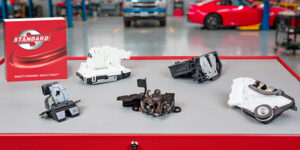This fictional story reimagines the role of an automotive shop in reducing operational costs as an environmental leader, bringing increased profitability and new jobs

Chapter One: A New Vision
After returning from the SEMA 2025 show in Las Vegas, Joe returned to his shop with purposeful energy. He realized that he was not just fixing cars anymore; he was supporting a smarter, greener future.
The next Tuesday, Joe met Taylor, an EPA inspector.
“Morning, Joe,” Taylor said in a friendly voice.
“Morning, Inspector,” Joe replied, an anxious edge to his tone. He knew this visit was about his application for a new environmental permit.
“So, some new operational changes and equipment add-ons?” Taylor asks.
“Exactly,” Joe said, feeling a bit more comfortable. He had not just been spinning a line about being eco-friendly; he believed in the system.
“Good. Now, let us look at the files,” Taylor said, his eyes focusing on a stack of neatly filed manifest documents.
Chapter Two: Tangible Environmental Gains
The next day, Taylor returned, and they spent the morning in the shop. The air was cleaner today, thanks to the new ventilation system Joe had installed alongside the recycling system.
He showed him the barrels of reclaimed, slightly discolored solvent used for cleaning tools and equipment. “This used to be hazardous waste we paid a fortune to get hauled away. Now, it’s a reusable asset.”
“The real win is in the air quality,” Joe explained, pointing to the sophisticated filters above the spray booth. “By recovering a good percentage of the solvents, we’re cutting down on the VOCs released into the atmosphere. That’s good for the ozone and air quality in the community.”
Taylor was impressed by the tangible evidence. The data on his clipboard was aligning with what he saw in practice. The number of hazardous waste shipments had dropped by 70% in the last quarter alone.
Chapter Three: A Catalyst for Change
A week later, Joe was preparing for Taylor’s final visit. He had his business projections laid out. When Taylor arrived, he at once launched into his vision.
“Taylor, this is just the start,” he said, tapping a diagram on his desk. “The future benefits go beyond just what we’re doing. If every shop in the county adopted this, the collective impact would be massive. We’re talking about regional air quality improvements, less stress on local waste management facilities, and a healthier work environment for future mechanics.”
“What about the industry as a whole?” Taylor asked, leaning in.
“That’s the kicker,” Joe said excitedly. “As technology improves, the quality of reclaimed materials will get better. We are talking about the circular economy for automotive repair materials. It pushes manufacturers to create more easily recyclable products in the first place, knowing there’s a recovery stream waiting for them.”
Taylor smiled faintly. “So, your small shop is a catalyst for industry change?”
“Why not?” Joe said with a shrug. “Someone has to lead the way.”
“The future benefits are where this really gets interesting,” Taylor explained, holding up a small glass jar. “Beyond the immediate savings and waste reduction, a robust recycling infrastructure makes the entire industry more resilient. We are seeing more regulations globally on specific chemicals. Recycling allows shops to keep using products they have on hand for longer, ensuring business continuity even with supply chain disruptions.”
Joe thought about the news stories he had seen about material shortages and pricing. “So, it’s like a safety net?”
“Yes. It also positions your business as an environmental leader in the local community,” Taylor added. “Future customers, especially younger ones, actively seek out businesses with sustainable practices. It’s not just good for the planet; it’s good for your brand.”
Joe could see his new sign now: “Joe’s Auto – Committed to a Greener Planet.” It did not sound so cheesy anymore.
Chapter Four: The Ripple Effect
The closing chapter of Joe’s environmental journey saw Taylor concluding his inspection. Joe was explaining the full cycle of benefits.
“With the money we’re saving and the new business we’re generating, we’ve been able to do two things,” Joe said, leading Taylor back into the bustling shop. “First, we’ve absorbed the cost of some of the more expensive, eco-friendly equipment and materials, making our services more affordable for our customers.”
Taylor noted a young man intently working on an engine. “And second?”
Joe gestured to the young man. “We hired two new mechanics. Our expansion meant we needed more hands-on deck.” He patted the young man on the shoulder. “This is Mike. Graduated last year, and now he’s got a solid job with a shop that’s here to stay.”
Taylor put away his clipboard, the inspection complete. The evidence was undeniable. Joe’s Auto Service had transformed itself. It was no longer just a shop; it was a model of sustainable business.
“Joe,” Taylor said, extending his hand. “Your operation is an outstanding example of how environmental stewardship, when approached with commitment and ingenuity, can lead to lower operational costs, increased profitability, and even job creation. You’re fully compliant, and frankly, an inspiration.”
Joe grinned, wiping his hand on his rag before shaking hands. “Just doing my part, Taylor. Good for the planet, good for the community.”
Epilogue
By investing in recycling systems and other sustainable practices, Joe’s Auto Service significantly reduced operational costs, including a 70% decrease in hazardous waste disposal expenses. These efficiencies, coupled with an enhanced reputation as an environmental leader, resulted in increased profitability and the creation of new jobs.
Coauthored by Barry Thomas, President and CEO of BECCA Inc., and Steven Schillinger, a Professional Engineer (PE). Thomas has extensive experience improving cycle times, eliminating quality issues, and managing hazardous waste at finishing operations. Schillinger is known for speaking at automotive industry meetings on EPA, OSHA, and Fire Marshal regulations.









Comments are closed.